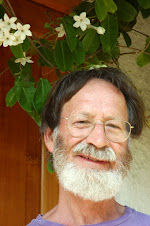I have since planted for butterflies, inspired by many wonderful visits to London Butterfly House and my membership of the admirable British Butterfly Conservation Society – of wider significance in its aim to protect woodlands. Although I enjoy the sight of crowds of butterflies on my lantana bushes, I miss the experience of having these flying flowers settle on my head as they did in the heated conservatories at Syon House by the river Thames.
Lantana with its little yellow and red clusters and prickly hard stems grows easily from cuttings and grows into a sprawling shrub more worthy than buddleia to be called “the butterfly bush”. An invasive weed in East Asia, it is welcome here, as it flowers every month in the year and is a magnet for every type of butterfly. Its scent is pungent but not unpleasant, more of an expensive after-shave than a seductive female perfume.
 Lavender on the drive attracts more bumblebees than butterflies; the bougainvillea a few whites and yellows; the wisteria, though on the north (warmer) side of the house, very few insects at all. Stephanotis – a climber I believe is named after the Greek Orthodox marriage crowns - is said to attract butterflies by the rich scent that exudes from its waxy white tubes but I have never caught a single one nectaring there. A real lepidopterist would have encouraged nettles and rotting fruit to provide breeding sites, but “murderer wasps” and the habit of wearing shorts has prevented such enthusiasm on my part.
Lavender on the drive attracts more bumblebees than butterflies; the bougainvillea a few whites and yellows; the wisteria, though on the north (warmer) side of the house, very few insects at all. Stephanotis – a climber I believe is named after the Greek Orthodox marriage crowns - is said to attract butterflies by the rich scent that exudes from its waxy white tubes but I have never caught a single one nectaring there. A real lepidopterist would have encouraged nettles and rotting fruit to provide breeding sites, but “murderer wasps” and the habit of wearing shorts has prevented such enthusiasm on my part.Scents that attract butterflies are not always those that make us swoon. These choosy insects spurn the “Lady Hamilton” sweets peas that make Chanel no. 5 smell cheap, preferring to lay their eggs on Fox’s Ear (in the case of the Swallowtail), a smelly creeper whose scientific name is Aristolochia chilensis.
Unlike those of tropical and sub-tropical Ecuador or Brazil, the colouring of Chilean butterflies is subdued. There are less species in Chile (169 diurnal butterflies) than in other South American countries, largely due to the country’s isolation. The Andes form a barrier on one side and the Pacific Ocean on the other of this narrow 2,000- mile strip of land.
The most common visitor to my garden is one of the largest: a brown and black swallowtail which, thanks to a mild form of colour blindness, I perceive as being my favourite dark green. It is fairly common from the Atacama Desert down to the procince of Concepcion in the south and migrates from Mexico to Argentina. From time to time it culls its own population by flying out in swarms to die in the ocean. I have seen two or three of these magnificent insects aggressively spiralling after swallows high above the eaves where they nest. But again, my poor vision may have led me astray in this “discovery.”
Among other species mobbing the lantana is one which, with its reddish brown patches and white spots, could be called the Chilean Red Admiral. It belongs to the same family (Vanessa) as the Admiral and, for some reason, was given the name Vanessa carye by the naturalist Hubner in 1806 in honour of a shrine of the Goddess Diana in Greece. The common name is “Afternoon Butterfly” because it basks on the hot stones at siesta time.
I nostalically recognize other visitors as “Cabbage Whites,” “Common Blues”, “Meadow Browns”, “Commas” and yellow “Brimestones”. But I am not out of step in referring to these British equivalents. The bilingual handbook “Las Mariposas de Chile” (Luis E. Pena, 1997) makes free use of some of these names in the translation from the Spanish. I have recently seen many “Skippers” – a curious small red furry “moth” which flies by day. And there is a rather nondescript “ hairstreak” whose larvae, I presume, feed off my winter-flowering llang-llang.
With the disapperance of habitats in Britain through intensive farming, chemical spraying, coal-mining and urbanization it occurs to me that “relocation” to Chile, in particular to my hermitage, would be a good idea. I would probably have to grow imported plants for breeding but the climate, which is semi-mediterrranean, might be favourable for British butterflies. To anyone who objects to this proposal on ecological grounds, I would say, If London Butterfly House can display butterflies from South America, why shouldn’t I show off the Purple Emperor, Peacock or Painted Lady from England?


No comments:
Post a Comment